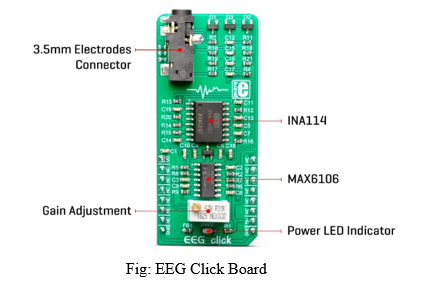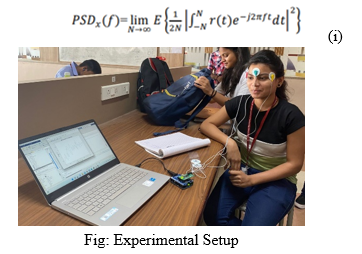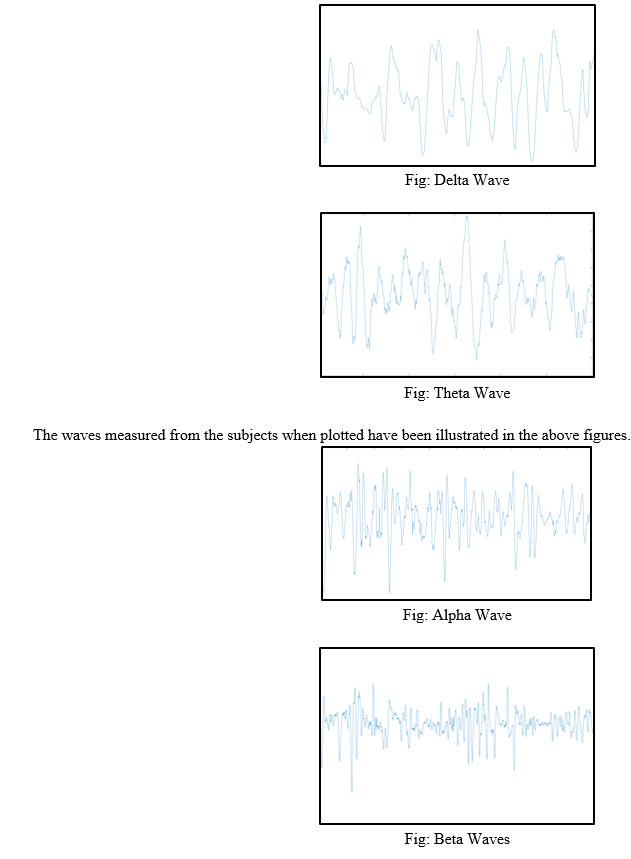Ijraset Journal For Research in Applied Science and Engineering Technology
- Home / Ijraset
- On This Page
- Abstract
- Introduction
- Conclusion
- References
- Copyright
Stress Analysis of Brainwave Using EEG Click
Authors: Shreya Dave, Dr. Bhavna Ambudkar, Neelum Dave
DOI Link: https://doi.org/10.22214/ijraset.2022.43448
Certificate: View Certificate
Abstract
People in today’s world thrive on perfection and performance, which leads to an increase in stress. The damage caused by stress is often underrated. An increase in stress affects our mental health and can lead to various long-term physical implications. These include diabetes, high blood pressure, headache, weak immune system, and many others It is a social phenomenon that needs to be monitored closely. Thus, it is necessary to detect stress in early-stage and take measures to reduce it. In our study, we aim to detect stress using brainwaves.
Introduction
I. INTRODUCTION
Whenever the body responds to any kind of excessive demand, it experiences stress[4]. It can be caused by both good and bad experiences. It is the feeling of emotional or physical tension. Any event that makes you feel angry, nervous or frustrated can lead to stress. When stress is for short durations, it can be positive, such as when helps you meet deadlines or avoid danger. Stress when present for a longer duration can be harmful to your health.
There are two main types of stress:
- Acute Stress: This is short-term stress that goes away quickly. It helps you manage difficult situations. It also occurs when you do something new or exciting. All people have acute stress at one time or another.
- Chronic Stress: This is stress that lasts for a longer period. Any type of stress that goes on for weeks or months is chronic stress. You can become so used to chronic stress that you don't realize it is a problem. If you don't find ways to manage stress, it may lead to health problems.
When you have chronic stress, your body stays alert, even though there is no danger. Over time, this puts you at risk for health problems, including:
High blood pressure, Heart disease, Diabetes, Obesity, Depression or anxiety, Skin problems, such as acne or eczema, Menstrual problems
II. MOTIVATION
According to researchers, a feeling of strain, and pressure in the human body is stress. While acute stress can be helpful as it may motivate us to complete our work in a given period of time but chronic stress may lead to serious health disorders. If this condition is not noticed it may have serious effects on the body[5]. When any person is under stress, the human body releases stress hormones called adrenaline and cortisol. This makes our heartbeats run at a faster rate. Other changes in humans are body tightening up and blood pressure rising also there can be trouble in breathing. Many Cardiovascular diseases are caused by a prolonged effect of stress on our body[9].
III. DETECTION OF STRESS
There are various ways to detect stress in our bodies.An electrocardiogram is one of the ways to measure stress. In this method, Heart Rate Variability is measured. The features Extracted from it help us identify the stress of a person.[9] Another great way to detect stress is using facial expressions. The human face is very expressive. Using Image Processing, Emotions can be detected, indicating whether a person is angry, sad, happy or depressed. These features can further be extracted to predict the stress level.[11]
Apart from this galvanic skin response is also an efficient way to measure Stress.[18]
The human brain is a complex circuit of neurons. All neurons communicate with each other using electrical signals. These Signals can be measured using an electroencephalograph. These signals received from EEG are known as brainwaves. Stress can be detected by the measurement of the frequency of brainwaves. Brain wave is a generic term used to refer to the electrical impulses generated by the neurons or during the interaction between them.[3] These impulses are observed by a measuring technique called an Electroencephalogram (EEG).
The EEG (electroencephalograph) measures brainwaves of different frequencies within the brain. Electrodes are placed on specific sites on the scalp to detect and record the electrical impulses within the brain. A frequency is the number of times a wave repeats itself within a second.
The raw EEG has usually been described in terms of frequency bands
- Delta (1-3 Hz): These are the slowest of all brainwaves and are strongest when we are enjoying restorative sleep in a dreamless state. This is also the state where healing and rejuvenation are stimulated, which is why it’s so crucial to get enough sleep each night.
- Theta (4-7 Hz): Theta brainwaves occur most often in sleep but are also dominant in deep meditation. Theta is our gateway to learning, memory, and intuition. In theta, our senses are withdrawn from the external world and focused on signals originating from within.
- Alpha (8-12Hz): Alpha brainwaves are dominant during quietly flowing thoughts and in some meditative states. Alpha is ‘the power of now, being here, in the present. Alpha is the resting state of the brain. Alpha waves aid overall mental coordination, calmness, alertness, mind/body integration, and learning.
- Beta (13-30Hz): Beta brainwaves dominate our normal waking state of consciousness when attention is directed towards cognitive tasks and the outside world. Beta is a ‘fast’ activity, present when we are alert, attentive, engaged in problem-solving, judgment, decision making, or focused mental activity.
- Gamma (>30Hz): Gamma brainwaves are the fastest of brain waves (high frequency, like a flute), and relate to the simultaneous processing of information from different brain areas. Gamma brainwaves pass information rapidly and quietly. The most subtle of the brainwave frequencies, the mind has to be quiet to access gamma.
IV. METHODOLOGY
EEG Click is a board that allows monitoring of Brainwaves. It is equipped with high sensitivity circuit that amplifies even the faintest electrical signals from the brain, allowing them to be sampled by the host MCU. In our project, we have taken Arduino as our Host MCU.
INA114 on the chip provides gain up to 10000. It provides low noise, LASER trimmed offset voltage, and a very good common rejection ratio. The gain on EEG Click is set about 12 times. Further, MCP6909 offers more amplification and filtering.
EEG click board provides an easy and cheaper solution to measure brainwaves compared to other solutions present in the market. The board is compact and compatible with multiple host MCUs such as ARM processors, PIC processors, Arduino, and Raspberry Pi.

Steps to collect the Data:
Step 1: Connect Click Board to Arduino using the Arduino shield.
Step 2: Attach the USB cable to the machine and turn on MATLAB.
Step 3: Run the code to start plotting the brain waves in real-time.
Step 4: Find the Power Spectral Density of the EEG Data Collected to find the frequency of the signal.
Step 5: Based on the frequency calculated, identify whether the Subject is stressed or not.
Step 6: Store the data file for future reference as a text file or CSV file using MATLAB.
Calculation of Power Spectral Density to determine the Frequency of Signal is done as follows:

V. EXPERIMENTAL RESULT
For our experiment, we collected the brainwave of 30 people: Staff Members and Students from Dr. D. Y. Patil Institute of Technology. The Brainwaves were measured before the viva exam began and after the exam ended. They were recorded for an average time of 120 seconds.
|
Sr.No. |
Profession |
Age |
Frequency Before Viva |
Frequency After Viva |
|
1 |
Professor |
39 |
16.13Hz |
12.26Hz |
|
2 |
Student |
20 |
13.86Hz |
9.44Hz |
|
3 |
Student |
21 |
10.82Hz |
11.38Hz |
|
4 |
Student |
21 |
10.73Hz |
11.61Hz |
|
5 |
Student |
21 |
11.053Hz |
8.23Hz |
|
6 |
Professor |
43 |
15.59Hz |
12.69Hz |
|
7 |
Professor |
39 |
12.97Hz |
11.86Hz |
|
8 |
Student |
21 |
10.81Hz |
8.43Hz |
|
9 |
Student |
21 |
11.54Hz |
11.29Hz |
|
10 |
Student |
20 |
10.97Hz |
11.16Hz |
|
11 |
Student |
20 |
11.33Hz |
10.30Hz |
|
12 |
Student |
21 |
12.73Hz |
12.08Hz |
|
13 |
Student |
21 |
17.62Hz |
11.95Hz |
|
14 |
Student |
19 |
18.66Hz |
15.24Hz |
|
16 |
Student |
19 |
12.73Hz |
13.24Hz |
|
17 |
Student |
21 |
10.49Hz |
10.4737 |
|
18 |
Student |
20 |
13.45Hz |
12.69Hz |
|
19 |
Professor |
47 |
10.45Hz |
11.03Hz |
|
20 |
Student |
21 |
18.23Hz |
12.55Hz |
|
21 |
Student |
22 |
17.68Hz |
14Hz |
|
22 |
Student |
21 |
15.24Hz |
12.53Hz |
|
23 |
Student |
20 |
14.652Hz |
13.34Hz |
|
24 |
Student |
20 |
11.42Hz |
12.83Hz |
|
25 |
Student |
20 |
13.28Hz |
12.58Hz |
|
26 |
Student |
21 |
12.72Hz |
12.05Hz |
|
27 |
Professor |
44 |
10.49Hz |
10.25Hz |
|
28 |
Student |
21 |
15.463Hz |
13.25Hz |
|
29 |
Student |
21 |
12.263Hz |
11.57Hz |
|
30 |
Student |
20 |
9.335Hz |
10.386Hz |
Table: Data Collected
It was noticed that for most of the subjects the brainwave frequency was reduced after the viva indicating that they were more relaxed after the exam thus the stress levels were reduced.

Conclusion
This paper proposes an automated system for stress detection using EEG signals. The frequency of Brainwave is detected using Power Spectral Density which a simple and robust. It has been noticed that once the stressful situation, in this case, an exam, is overcome the stress level automatically reduces. Stress can be relieved in various ways such as through Music Therapy, Yoga, Meditation, Exercise, Art, Reading, and so on. In the future Stress reduction using music can also be implemented using machine learning and deep learning technique-based recommender systems.
References
[1] Chung-Yen Liao, Rung-Ching Chen, Shao-Kuo Tai,” Emotion Stress Detection using EEG Signal and Deep Learning Technologies”, IEEE International Conference on Applied system Invention, 2018 [2] Shubhangi Gond, Bhavna Ambudkar, Afzal Ali Syed,” Human Stress Detection and Relief using Music Therapy”, IJRECE,2019 [3] L. Malviya, S. Mal and P. Lalwani, \"EEG Data Analysis for Stress Detection,\" 2021 10th IEEE International Conference on Communication Systems and Network Technologies (CSNT), 2021 [4] Khongorzul Munkhbat, Keun Ho Ryu, “Classifying Songs to Relieve Stress Using Machine Learning Algorithms”, Springer 2020. [5] A. Raj and S. M. Jaisakthi, \"Analysis of Brain Wave Due to Stimulus Using EEG,\" 2018 International Conference on Computer, Communication, and Signal Processing (ICCCSP), 2018 [6] Christos Papadelis et al. \"Using brain waves to control computers and machines\", Advanced Human-Computer Interaction, vol. 2013. New York: Hindawi Publishing Corporation, pp.1-2, 2013. [7] Chen-Yen Liao, Rung-Ching Chen, Shao-Kuo Tai, Hendry,” Using Single Point Brain Wave Instrument to Explore and Verification of Music Frequency”, ICITech IEEE 2017 [8] Chung-Yen Liao, Rung-Ching Chen, Shao-Kuo Tai,” Emotion Stress Detection using EEG Signal and Deep Learning Technologies”, IEEE International Conference on Applied system Invention, 2018 [9] R. Ramteke and V. R. Thool, \"Stress detection of students at academic level from heart rate variability,\" 2017 International Conference on Energy, Communication, Data Analytics and Soft Computing (ICECDS), 2017 [10] C. Han, Y. Yang, X. Sun and Y. Qin, \"Complexity Analysis of EEG Signals for Fatigue Driving Based on Sample Entropy,\" 2018 11th International Congress on Image and Signal Processing, BioMedical Engineering and Informatics (CISP-BMEI), 2018 [11] A. Bannore, T. Gore, A. Raut and K. Talele, \"Mental stress detection using machine learning algorithm,\" 2021 International Conference on Electrical, Computer, Communications and Mechatronics Engineering (ICECCME), 2021 [12] K Devendran, S K Thangarasu, P Keerthika, et.al, “Effective prediction on music therapy using hybrid SVMANN approach”, ITM Web of Conferences 2021. [13] K Devendran, S K Thangarasu, P Keerthika, et.al, ” Music Prediction for Music Therapy using Random Forest”, International Journal of Control and Automation, 2020. [14] Esther Ramdinmawii, Vinay Kumar Mittal,” The Effect of Music on the Human Mind: A study using Brainwaves and Binaural Beats”, IEEE 2017 [15] Deepika R.Chavan, M.S.Kumbhar, Rohit R.Chavan, “The Human Stress Recognition of Brain, using Music Therapy ”, ICCPEIC 2016 [16] G. Ambica, B.Sujata, Study and application of brainwaves, IJCSMC 2015. [17] Nicole Hurless, Aldijana Mekic, et al, “Music genre preference and tempo alter alpha and beta waves in human non-musicians “, Impulse: The Premier Undergraduate Neuroscience Journal 2013. [18] A. de Santos Sierra, C. Sánchez Ávila, G. Bailador del Pozo and J. Guerra Casanova, \"Stress detection by means of stress physiological template,\" 2011 Third World Congress on Nature and Biologically Inspired Computing, 2011 [19] Garcia Cortes, J. Marti, I. Sayago, J.P.Santos, “Detection of stress through sweat analysis with an electrode nose” Feb 2009 Spanish conference on Electronic devices. [20] www.google.com/amp/s/amp.livescience.com/49452-trackers-measure-stress-heart-rate-variability.html [21] Andrew Campbell et al. in his paper NeuroPhone: brain-mobile phone interface using a wireless EEG headset
Copyright
Copyright © 2022 Shreya Dave, Dr. Bhavna Ambudkar, Neelum Dave. This is an open access article distributed under the Creative Commons Attribution License, which permits unrestricted use, distribution, and reproduction in any medium, provided the original work is properly cited.

Download Paper
Paper Id : IJRASET43448
Publish Date : 2022-05-27
ISSN : 2321-9653
Publisher Name : IJRASET
DOI Link : Click Here
 Submit Paper Online
Submit Paper Online

